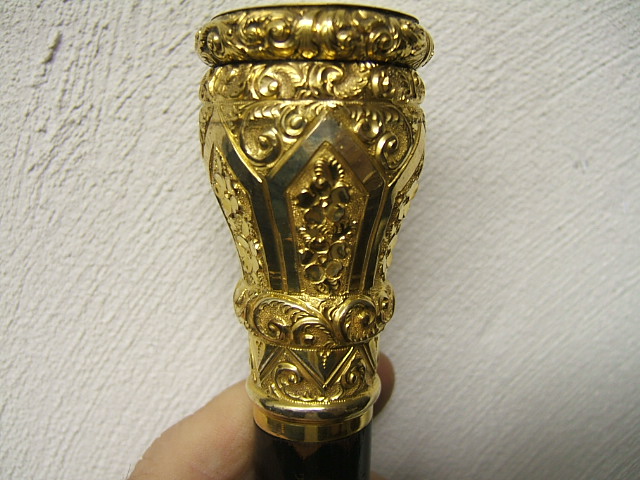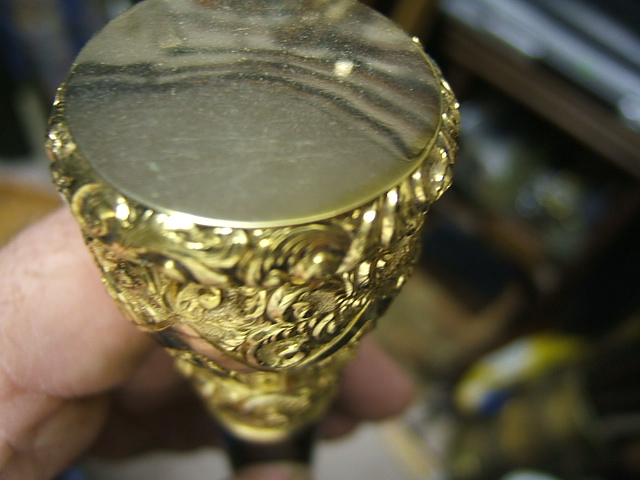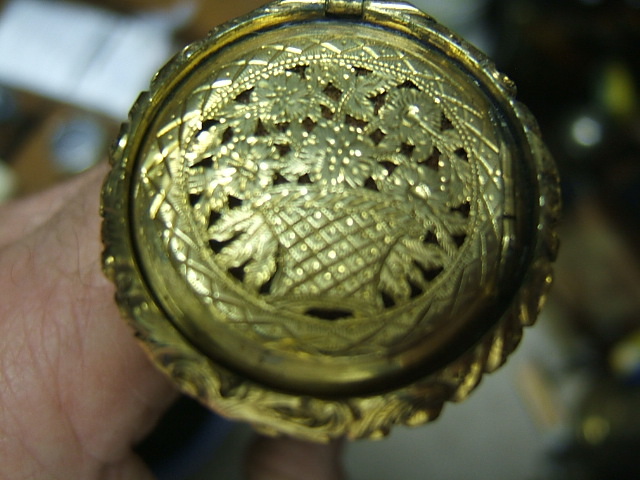 The difference between Vinaigrettes ,pomanders, smelling salt, and scent canes to make hands smell pretty (8507) The difference between Vinaigrettes ,pomanders, smelling salt, and scent canes to make hands smell pretty (8507)
This is the first of several vinaigrettes. What Iím about to tell you, took me for a long time to figure out, because again very little is written about the use of so many gadget canes, other than their names. There are four different names for canes that are similar but different. Pomanders, vinaigrettes, smelling salts, and perfumes. I just went back and read Catherine Dikes description of this subject in Cane Curiosa and two things came to mind. It shouldnít have taken me so long to figure it out, she has a helpful description in the introduction to chapter 17, and Iím going to reproduce it here. If her book is ever reissued, I'll eliminate this paragraph. With her book selling for $400, there are not enough of them to go around even if you were willing to pay the price. Then Iím going to add what I have learned along the way and hopefully will help you appreciate how important canes were to this interesting part of history. ďThroughout history vinegar has been ascribed medicinal value: Hippocrates prescribed it for his patients. And in the 18th, 19th and early 20th centuries, vinegar was still believed to have preventive and healing virtues. Thus, a sponge soaked in spiced vinegar was in great demand and placed in a handy vinaigrette (a small metal box), locket or cane. Vinegar was considered an antidote for practically everything. There was even a virgin's vinegar to replace what could be lost only once! Due to the tight lacings of their corsets, women often fainted and had to depend on their vinaigrette to revive themselves.
It is interesting to compare encyclopedias from both the 19th and the 20th century. The present-day encyclopedia gives a short, technical description of how vinegar is obtained, while the earlier one devotes numerous columns to vinegar's various healing virtues, in both liquid and salt form. In France, it took the name sel d'Angleterre (English smelling salts). The English adopted the name vinaigrette for the container of there aromatic substance. Doctors also relied upon vinaigrettes as prevention against epidemic diseases also sometimes dampened with perfume to fight the bad odors which floated in streets, coaches and most public places. Similar to vinaigrettes, which have a lid, cane handles could have perforated holes above a cavity. Some canes with perforated ivory handles were doctors' pomanders, while others were used to perfume the hand that held it."
The vinaigrette pictured is unusual because itís an American Presentation cane. Iíve never seen another. Most are European. Iím told by collectors that most were not used with a vinegar based solution, as its name implies, but a sweeter solution like perfume. Iím told the most difficult thing about living in the nineteenth century and before were was the smells of body odor. Remember there was no deodorant and no indoor plumbing. There were only outhouses where would they even get a bath or a shower. Its obvious the filler was vinegar based in the beginning, but its use for the majority of its life changed for those with covers. The grill on the top of this one is particularly ornate. The lid which is plain, proves itís a presentation, because it was meant to be engraved on. Most non presentations had ornate tops. The compartments are very small in vinaigrettes, as compared to pomanders, this supports the theory that the strong smell of perfume didnít need as large a space There was a sponge in both of these types. I think the smelling salt container canes are the rarest. I know the one in Dikes is not one because the opening is to small to get the salts in, they had a wide mouth. Iíve seen many pocket smelling salt containers and they are all have the same wide mouth. I also have only seen a couple. Perfume containers have the most varieties, and are the easiest to reproduce by putting an atomizer on the handle or a separate perfume bottle inside a shaft. The bottles are plentiful and inexpensive. Dike mentions one cane I didnít know existed and I didn't know how to illustrate one, that is one with holes in the handle to make the hand smell pretty. When you think about the custom of kissing womenís hands, it makes sense there would be a need for one, but again I have always defined those with no lids doctors pomanders. If you read the information on the Dike collection, it shows her cane that was made to make the hand smell pretty. Its the first and only one I have ever seen documented by such a reliable source. Our purpose today was to give you an introduction to an interesting topic, and it will be prolifically added to as we add canes to these categories. Vinaigrettes have lids and pomanders don't, how difficult should that have been to figure out. I've seen several small canes with grills or holes, from now on I'm going to assume they were for sweet smelling hands, they are too small for a doctor.
Category: Gadget
Sub Category: City - Manufactured
Listed: 2006-07-03 20:19:40
|










 Online Video
Online Video








